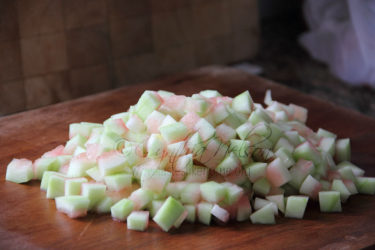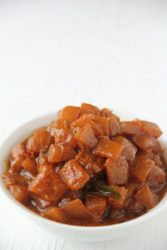Hi Everyone,
Eat and drink your belly full of sweet juicy watermelon but don’t toss the rind; cook it.
Cucumbers and watermelons belong to the same family, and just as all parts of a cucumber are edible, so too are all  parts of a watermelon. Eating the rind is not a new phenomenon, people in various parts of the world cook and eat watermelon rind when it is in season. One of the most popular ways we’ve probably heard of the rind being used is as a pickle. The firm white rind is crisp, it can endure the acidity required for preservation and the heat needed to soften it for a stew, curry, soup, or stir-fry.
parts of a watermelon. Eating the rind is not a new phenomenon, people in various parts of the world cook and eat watermelon rind when it is in season. One of the most popular ways we’ve probably heard of the rind being used is as a pickle. The firm white rind is crisp, it can endure the acidity required for preservation and the heat needed to soften it for a stew, curry, soup, or stir-fry.

Photo by Cynthia Nelson
Think of the watermelon rind as you would squash (bottle gourd); same cooking techniques can be applied, same texture when cooked, same ability to absorb the flavour of whatever it is cooked with. And the best part of it all is this – you get to eat the fruit of the watermelon and the vegetable rind; that is money well spent.
Most of my watermelon-rind eating has been as a light pickle. With the green skin removed, the rind would be cut into slices (just as I would cucumbers) and doused with a mixture of fresh lime/lemon juice, salt and finely minced hot pepper. Sometimes, I’d use vinegar in place of the citrus juice. It’s always refreshing and tasty. I’d eat it by the bowl full. However, the other day, after cutting up an entire watermelon, I knew that there was no way I was going to be able to eat all of the rind as a pickle so I opted to cook the rind. I decided to make a curry (please say you are surprised). I figured that I could eat the curry with rice for lunch and then have some of it with Sada roti for dinner or a late breakfast.
Here’s what I did and how it turned out.
I had coconut milk left back from another dish I was making that day so I figured, what the heck, I’ll add that to the curry. It was a very good decision (even if I say so myself).
Looking at the slight red hue on the rind, I opted to add a little tandoori masala to my house-blend masala to make the curry, in honour of the redness of the watermelon.

Photo by Cynthia Nelson
- Peel the green skin with a vegetable/potato peeler. It is the easiest way of removal. Cut the peeled rind into half to one-inch pieces.
- The watermelon rind is firmer and crisper than that of squash/bottle gourd and so it holds its shape a little better and has good texture when cooked.
- It does not “spring” a lot of water when cooked. There was moisture in the curry because I added coconut milk and wanted the vegetable to be infused with the flavour.
- The curry was cooked uncovered until all the moisture was absorbed.
- The rind quickly and easily absorbs whatever seasonings or flavourings with which it is cooked.
- There was a subtle hint of sweetness when cooked.
- Adding a little bit of sour such as tamarind pulp makes the curry very pleasing on the palette.
- When cooked, the rind reduces to a little more than half (in volume).
I loved the curried watermelon rind and will definitely be making the rind a part of my vegetable intake whenever watermelons are in season.
Most of the times when we buy watermelon it is always as a portioned piece because we primarily buy and eat it for the fruit, so take into consideration the size of the watermelon you are buying if you plan to cook it as a vegetable too. And don’t worry if the watermelon is large, it is so versatile – you can juice it and make all sorts of drinks, fruit soups, freeze it booze infused and like I said, eat your belly full.
The next time you are headed to the market, pick up a watermelon, eat the fruit and cook the rind. Let me know what you make and how it turned out for you.
Cynthia









